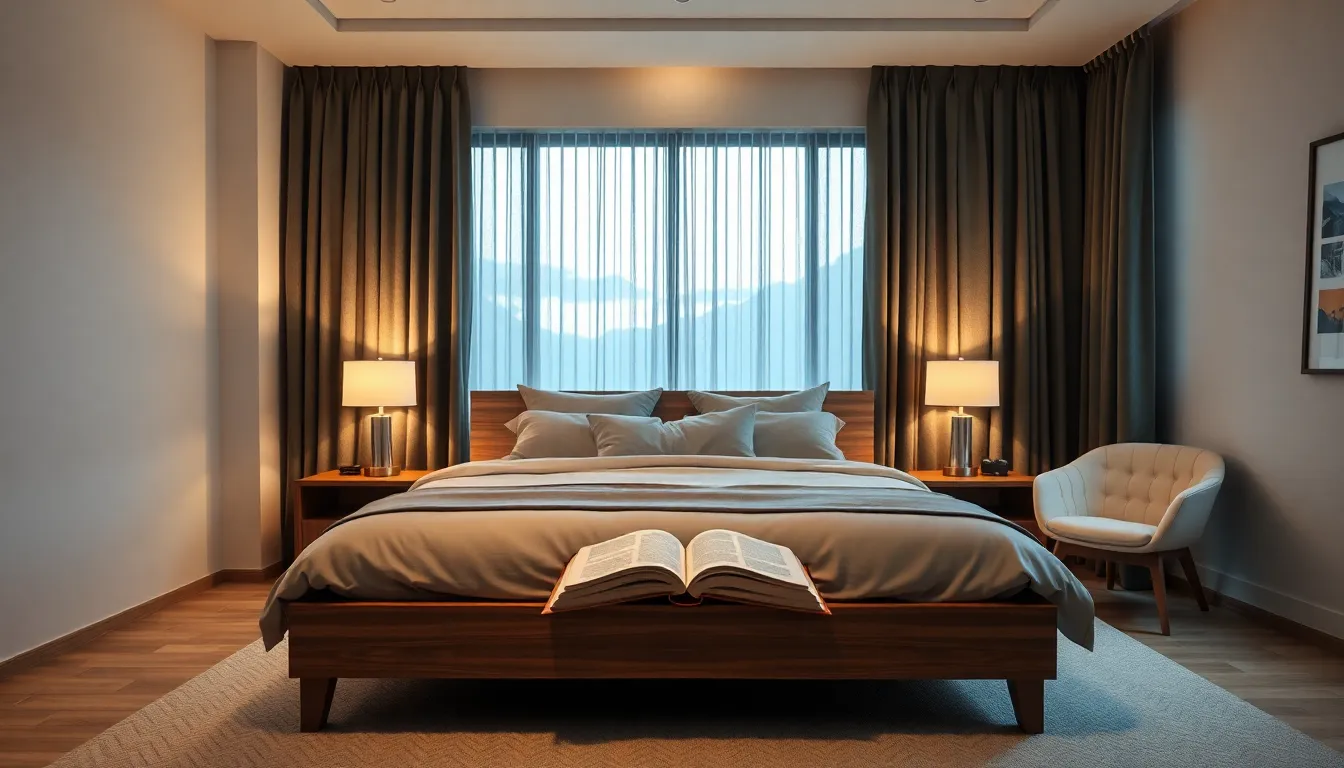Table of Contents
ToggleSetting the mood can turn an ordinary evening into an unforgettable experience. Whether it’s a romantic dinner, a cozy movie night, or a lively gathering with friends, the right lighting can make all the difference. Imagine dimming the lights just right and watching as the atmosphere transforms. Suddenly, you’re not just in a room; you’re in a scene from a movie—minus the awkward plot twists.
Understanding Mood Lighting
Mood lighting significantly impacts the overall ambiance, influencing how spaces feel. Utilizing lighting thoughtfully can enhance experiences, making moments feel special.
The Psychology of Light
Light affects emotions in various ways. Research shows that warm light promotes relaxation, while bright light can elevate energy levels. Understanding these effects allows individuals to choose appropriate lighting for settings. Dimmed lights often create a sense of intimacy, making environments suitable for gatherings or romantic dinners. Cool tones may evoke alertness and concentration, enhancing workspaces. Different scenarios benefit from different lighting styles, emphasizing the connection between light and mental states.
Effects on Mood and Atmosphere
Lighting directly influences mood and atmosphere. For instance, soft, warm light softens harsh features in a room, fostering a cozy environment. In contrast, harsh fluorescent lighting may lead to feelings of stress and discomfort. Colored lights can also set specific moods; for example, blue often conveys tranquility, while red can energize and excite. Every choice in lighting contributes to the overarching feel of the space, whether for relaxation at home or a celebratory gathering. Understanding these effects ensures optimal lighting to create the desired atmosphere.
Types of Mood Lighting
Mood lighting encompasses various styles, each creating a distinct atmosphere. Understanding these types helps in selecting the right setup for any occasion.
Ambient Lighting
Ambient lighting serves as the primary light source in a room. It provides a uniform level of illumination, ensuring spaces feel welcoming and comfortable. Soft, warm bulbs frequently create this effect, promoting relaxation. For instance, floor lamps with dimmers offer adjustable brightness to enhance the desired mood. Walls or ceilings can reflect light from fixtures, further softening the space. When planning a living area for gatherings or quieter evenings, ambient lighting plays a crucial role in shaping the overall experience.
Task Lighting
Task lighting focuses on illuminating specific areas for activities. This type of lighting increases functionality in workspaces or reading corners by reducing eye strain. Desk lamps or pendant lights positioned over kitchens or workstations ensure efficiency and comfort. Choosing adjustable options allows individuals to control brightness according to their needs. For reading or crafting, using a well-placed task light enhances productivity while maintaining a cozy atmosphere. This specific lighting type complements ambient lighting, contributing to a well-rounded setup.
Accent Lighting
Accent lighting emphasizes particular features or decor within a space. Highlighting artwork, plants, or architectural elements creates visual interest and depth. Spotlights or wall-mounted fixtures are commonly used for this purpose, drawing attention to focal points. Colored bulbs can add drama and create intriguing contrasts. During social gatherings, using accent lighting sets a playful tone and enhances the ambiance. When combining these lights with ambient and task lighting, it elevates the overall aesthetic while creating a layered effect.
Setting Up a Mood Lighting System
Creating a mood lighting system involves careful consideration of fixtures, bulbs, and intensity control to enhance the atmosphere effectively.
Choosing the Right Fixtures
Selecting fixtures plays a crucial role in establishing the desired ambiance. Pendant lights, floor lamps, and wall sconces each contribute uniquely to the space. Pendant lights work well over dining areas, adding elegance. Floor lamps serve versatile purposes, providing light in various seating arrangements. Wall sconces bring a touch of sophistication while freeing up surface space. Opt for fixtures that complement the decor style and allow for easy placement.
Selecting the Ideal Bulbs
Choosing the right bulbs significantly impacts mood and energy efficiency. LED bulbs offer longevity and different color temperatures. Warm white bulbs create a cozy feel, perfect for relaxation areas. For workspaces, cool white bulbs enhance concentration. Dimmable options provide flexibility, allowing adjustments according to preference. Colored bulbs introduce creative elements, setting the mood for special occasions or themed parties. Consider the bulb’s wattage and brightness to match the atmosphere.
Controlling Lighting Intensity
Adjusting lighting intensity enhances ambiance and comfort. Dimmer switches allow quick changes for various activities, from romantic dinners to lively gatherings. Layering light sources adds depth and dimension to the space. Combining ambient, task, and accent lighting creates a balanced atmosphere. Smart lighting systems offer remote control, enabling convenient adjustments based on time of day or preference. Incorporate these adjustments to tailor the environment to specific moods and settings.
Tips for Creating the Perfect Mood Lighting Setup
Creating the ideal mood lighting setup requires careful planning and consideration of various elements. Attention to detail in choice and placement can enhance the overall atmosphere significantly.
Color Temperature Choices
Selecting the right color temperature impacts overall ambiance. Warm white light, ranging from 2700K to 3000K, promotes relaxation and coziness, making it ideal for living rooms and bedrooms. In contrast, cool white light, above 4000K, can increase focus and energy, perfect for workspaces or kitchens. Also, consider using colored bulbs to evoke specific emotions; blue light conveys tranquility while red energizes the environment. By mixing different temperatures, one can create a dynamic space that caters to various activities and moods.
Layering Light Sources
Layering light sources enhances depth and visual interest in any space. Ambient lighting serves as the foundation, providing overall illumination. Task lighting, such as desk lamps or under-cabinet lights, focuses on specific activities, improving functionality. Accent lighting, used strategically to highlight artwork or architectural details, adds personality and character. Combining these three types creates a well-rounded lighting setup, allowing for both practical use and aesthetic appeal, transforming ordinary areas into inviting environments.
Utilizing Smart Lighting Solutions
Employing smart lighting solutions elevates mood lighting customization. Smart bulbs and fixtures allow users to adjust brightness, color, and even scheduling through a mobile app or voice command. Integration with home automation systems enables seamless control, letting users set different moods for various occasions, from casual gatherings to movie nights. Additionally, using dimmers provides further flexibility to tweak the lighting intensity, ensuring the ideal atmosphere is achieved easily. These innovations streamline the lighting experience, making it convenient and adaptable to one’s lifestyle.
Creating the perfect mood lighting setup can significantly enhance any environment. By understanding the effects of different lighting types and color temperatures, individuals can tailor their spaces to evoke specific emotions and atmospheres. Layering ambient, task, and accent lighting not only adds depth but also ensures functionality and comfort.
With advancements in smart lighting technology, achieving an ideal ambiance has never been easier. Customizable controls allow for quick adjustments, ensuring that every occasion feels special. Investing time in thoughtful lighting choices can transform ordinary moments into unforgettable experiences.







